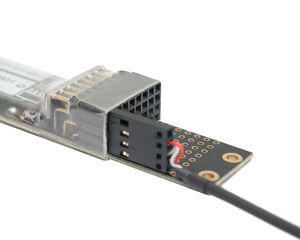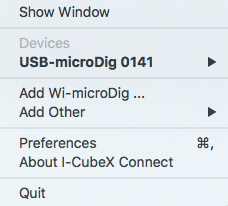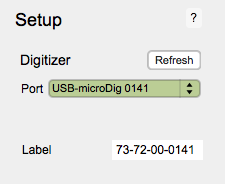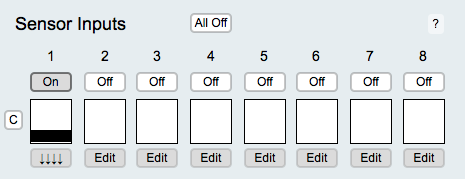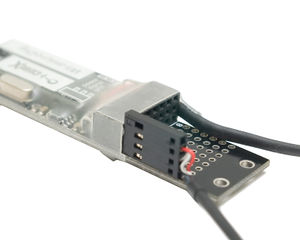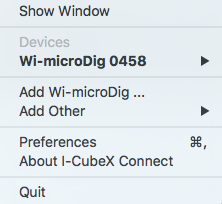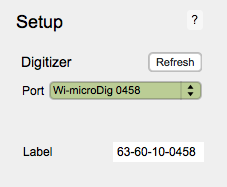Difference between revisions of "EditorX-73 QuickStart"
| Line 33: | Line 33: | ||
| − | 3. The USB-microDig entry with matching serial number should be listed in bold. If you don't see the USB-microDig listed, verify that the [http://icubex.com/umddriver driver] has been installed. | + | 3. The USB-microDig entry with matching serial number should be listed in bold in Connect. If you don't see the USB-microDig listed, verify that the [http://icubex.com/umddriver driver] has been installed. |
Revision as of 16:08, 14 December 2016
Here's how to get started with EditorX. Connect a USB-microDig or Wi-microDig and configure it to get and process sensor data, and output the processed data.
Contents
USB-microDig
What you need
For this walkthrough, you will need:
- A USB-microDig and its drivers (see below).
- A Turn (or other) sensor for testing.
- EditorX software.
- Connect software (included in the EditorX software package).
Installing the USB-microDig
In both Windows and MacOS, you'll first need to add the USB-microDig as a virtual serial (or COM) port by installing its SiliconLabs driver.
In Windows, LoopMIDI virtual MIDI port software needs to be installed as well. There's no need to create any ports in LoopMIDI.
Connecting to the USB-microDig
1. Connect the Turn sensor (or any other sensor) to input #1 of the USB-microDig as shown below, with the red wire on top and the black wire on the bottom.
2. Start Connect.
3. The USB-microDig entry with matching serial number should be listed in bold in Connect. If you don't see the USB-microDig listed, verify that the driver has been installed.
4. Start EditorX. Note that in MacOS, the next time you run EditorX and Connect isn't already running, Connect will be started automatically when starting EditorX.
5. In the Setup section at the top, choose the USB-microDig with matching serial number. Upon connecting, the port menu will turn green. If EditorX failed to connect to the digitizer, maybe the Connecting section on the Setup page can help you resolve the issue.
6. Click the "Off" button under number "1" in the Sensor Inputs section to turn on sampling of sensor input 1. The box right below the button will show the sensor value if changed. If it doesn't show anything, click the "Clear" button in the Settings section at the top right of EditorX, and try again to turn on the sensor input.
7. You're up and running. For further details about using EditorX, refer to the EditorX help pages.
Wi-microDig
What you need
For this walkthrough, you will need:
- A Wi-microDig and its drivers (see below).
- Bluetooth adapter (built in to your computer if it's a Mac).
- A Turn (or other) sensor for testing.
- EditorX software.
- Connect software (included in the Link software package).
Installing the Wi-microDig
In both Windows and MacOS, you'll first need to add the Wi-microDig as a Bluetooth device with a virtual serial (or COM) port. The instructions here explain how to do this.
In Windows, LoopMIDI virtual MIDI port software needs to be installed as well. There's no need to create any ports in LoopMIDI.
Connecting to the Wi-microDig
1. Connect the Turn sensor (or any other sensor) to input #1 of the Wi-microDig, as shown below, with the red wire on top and the black wire on the bottom.
2. Start Connect.
3. In MacOS, in Connect, enable the Wi-microDig with matching serial number. Once enabled, the blue LED on the Wi-microDig will illuminate and the Wi-microDig entry will be listed in bold. If you don't see the Wi-microDig listed in Connect, make sure it was added as a Bluetooth device to the operating system and added in Connect.
3. In Windows, wait until a message has appeared in the Windows System Tray confirming that the Wi-microDig has been recognized by Connect. Ignore any system tray messages regarding a failed connection with a Standard Serial over Bluetooth link. Once enabled, the blue LED on the Wi-microDig will illuminate and the Wi-microDig entry will be listed in bold. If you don't see the Wi-microDig listed in Connect, make sure it was added as a Bluetooth device to the operating system and that LoopMIDI was installed.
4. Start EditorX. Note that in MacOS, the next time you run EditorX and Connect isn't already running, Connect will be started automatically when starting EditorX.
5. In the Setup section at the top, choose the Wi-microDig with matching serial number from the pulldown menu. Upon connecting, the port menu will turn green. If EditorX doesn't connect to the Wi-microDig, check that your Bluetooth is turned on, that the Wi-microDig is powered and that it is listed in bold in Connect. EditorX will not warn you if once of these conditions hasn't been met, it will just not connect. If you can't get EditorX to connect to the digitizer, maybe the Connecting section on the Setup page can help you resolve the issue.
6. Click the "Off" button under number "1" in the Sensor Inputs section to turn on sampling of sensor input 1. The box right below the button will show the sensor value if changed. If it doesn't show anything, click the "Clear" button in the Settings section at the top right of EditorX, and try again to turn on the sensor input.
7. You're up and running. For further details about using EditorX, refer to the EditorX help pages.
